Saving Trees That Helped Save Dust Bowl America
Air Date: Week of January 12, 2018
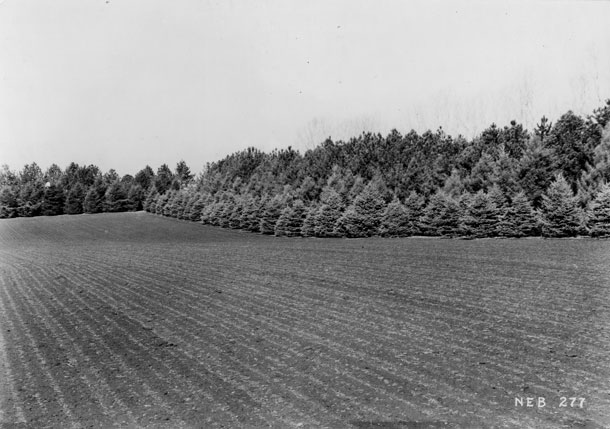
A shelterbelt in Burt County, Nebraska, photographed in 1937. The simple aesthetic of a stand of trees in an otherwise totally flat landscape had a powerful sentimental as well as ecological impact, says Vaughan. (Photo: The Forest History Society, Durham, NC)
The Great Plains were the nation’s breadbasket, but drought in the 1930s created the Dust Bowl. President Franklin Delano Roosevelt’s solution was to plant trees as a shelterbelt to help hold back the dust. The plan worked, but now some farmers, forced by economic necessity to maximize crop yields, are cutting them down. Journalist Carson Vaughan of the Food and Environment Reporting Network joins Host Steve Curwood to examine the country’s increasingly vulnerable great wall of trees.
Transcript
CURWOOD: The Dust Bowl was a great American disaster. As they moved west in the 19th century, settlers ploughed under the seemingly endless prairie to produce grain. At first it went well, but by the 1930’s the rains failed, and the wind tore away the topsoil by the ton, sending it flying across the Great Plains, choking livestock and homes and people, and driving them off the land.
President Franklin Delano Roosevelt had an answer. He mobilized the US Forest Service, the Civilian Conservation Corps and the Works Progress Administration to create shelterbelts by planting millions of trees to hold down the earth. Decades later many of those trees still stand as a vital green protective strip, but the shelter belts face a new threat from farmers eager to maximize their annual harvests. Carson Vaughan wrote about the shelterbelts for the Food and Environment Reporting Network, and joins us now from Omaha Nebraska – welcome to Living on Earth!
VAUGHAN: Happy to be here.
CURWOOD: So, Carson, you're in Nebraska now. If you could go back in time, say 80 years, what would the Dust Bowl have looked and felt like there?
VAUGHAN: Yeah, we're talking heavy winds, one year after another of very intense drought and that just got emotionally, and certainly physically draining, for farmers and ranchers out in the Great Plains. I researched one specific farmer in Nebraska who farmed near a now kind of ghost town called Inavale and each year it got a little bit worse and a little bit worse and his crops went from fairly good in the late '20s to progressively worse and he kept a diary, so see you can see him undergoing physical and mental turmoil. His crops are literally blowing away right in front of him. Each year is getting hotter and drier and they're running out of water and their cattle are dying, they're choking on the dust, you know, and people were dying from this. And their cattle certainly were and their crops certainly were and they were running out of money and running out of hope.
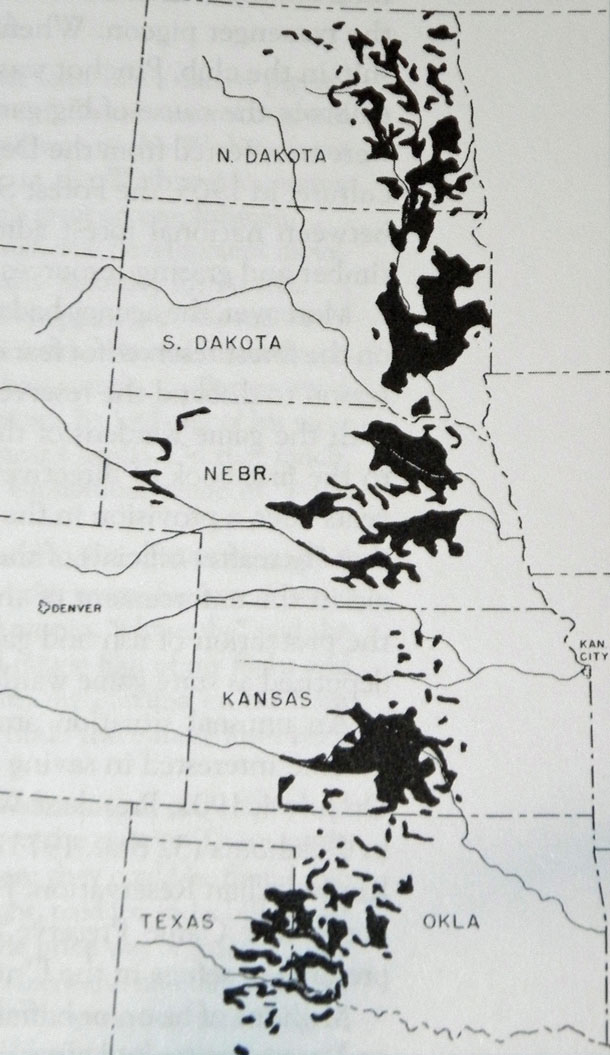
The major planting areas of the Shelterbelt Project from 1933-1942. (Photo: U.S. Forest Service, Wikimedia Commons CC)
CURWOOD: So, how did this idea of for the wall of trees come about?
VAUGHAN: Well, it's sort of legend at this point. I couldn't track down the original source, but a lot of journalists back in the day were citing a story of FDR, then Governor Roosevelt, was campaigning in Montana and his train was delayed by a wind eroded hillside in Butte, Montana. And apparently at that time he started brainstorming and came up with this plan of, what if we had this solid wall of trees running up and down the plains that provided some sort of blockage for that dust blowing around everywhere, and so that was FDR's original plan.
He wanted literally a single wall of trees several miles wide running from the Canadian border all the way down to the Texas panhandle. Now, that was later on modified a little bit by his advisors and by the Forest Service director and that kind of thing and they turned it into forest protection strips. And so it still went from North Dakota all the way down to the Texas panhandle but it wasn't one solid wall of trees. It was a series of walls of trees all the way down.
CURWOOD: So, described this great green wall of trees. What kind of trees it made of?
VAUGHAN: All sorts of trees. The Forest Service at the time tried their best to use trees that were native to the regions they were planting them in, and when they couldn't do that they used exotics, but exotics that they had already proven to be reliable trees for a shelterbelt. So, they were using you know, pines, oaks. They kind of used cottonwoods as the PR campaign for shelterbelts. In the long run cottonwoods aren't the best. Their lifespan isn't as long but they grew very quickly in pretty poor soil and so they could point to those after planting just the year before and say look out quick these trees are growing, look how sustainable this is.
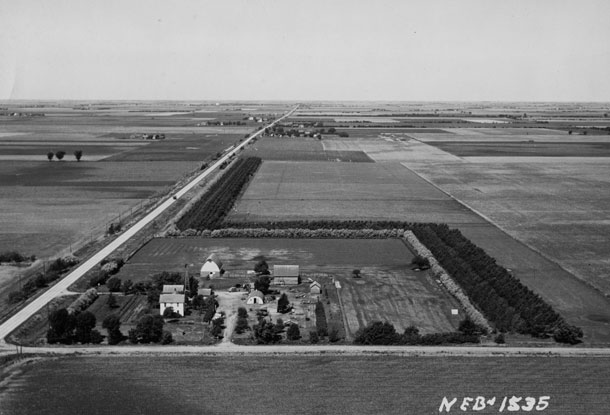
A shelterbelt on the Albert Stuhr farm in York County, Nebraska, 1947. Forest Service and Civilian Conservation Corps workers first began planting shelterbelts in the 1930s and 1940s to provide protection against Dust Bowl storms. (Photo: The Forest History Society, Durham, NC)
CURWOOD: So, how effective was it at stabilizing the land and protecting the topsoil and how effective is it still today?
VAUGHAN: It was very effective. The fact that there are still up today, at least a portion of them, I think is sort of testament to their usefulness. Certainly we're seeing them torn down more and more all the time, and that's sort of the crux of my story, but they served a huge purpose at the time. I mean, obviously to plant 220-some million trees, that's a long-term effort. So, they started planting in '35. I think the first tree was in a town called Mangum, Oklahoma, and they planted for another decade and off and on they're still planted all the decades up until now and some farmers are still planting them, but people saw a real benefit to curbing all this dust blowing everywhere. I mean, it was one of the few technologies to prevent that.
CURWOOD: Chris, this shelterbelt as you call it, it just sounds so lovely so why would anyone want to cut it down?
VAUGHAN: Yeah, I mean that's a more difficult question than I had originally thought it was going into this reporting, but there are multiple reasons, the biggest of which is as you know a lot of these environmental stories turn out to be, it's money, you know, it's the economics of it all. Farmers, they see commodity prices go high and they think, well, this shelterbelt may have done something for me at one point but they're kind of in the way of what could be more row crops for me and row crops are more profitable than these trees.
So, they rip out these trees, they plant more crops and they make more money. The flip side of that though and the irony here is that in a bad here when commodity prices are low, that's another justification to rip out the trees and keep planting more because they need to like soak up every penny they can from those crops. So, whether it's a good year or a bad year, we find farmers finding a justification to rip out these trees.
CURWOOD: So, how wise is this deforestation with climate disruption continuing, drought such a danger in much of the center of our nation?
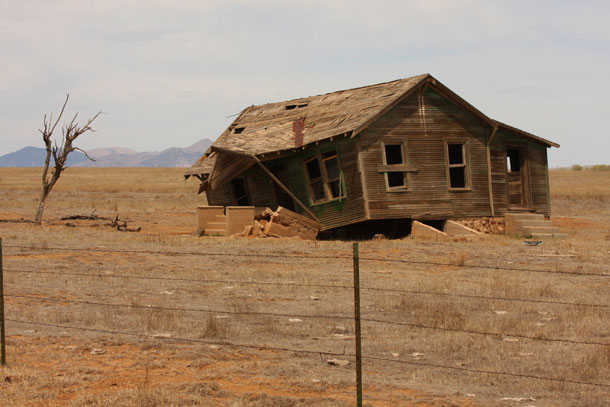
An abandoned house decays in Northeastern New Mexico. The Dust Bowl brought drought and deadly dust storms to the West during the 1930s and forced many families to abandon their homes. (Photo: J.N. Stuart, Flickr CC BY-NC-ND 2.0)
VAUGHAN: Yeah, I mean I think if you talk to most agro-forestry officials out here in the Great Plains they would tell you that it's a pretty short-sighted move to be tearing out these trees right now, and that's certainly not to generalize every farmer, every rancher in the Great Plains. Certainly a lot of them have that conservation ethic and understand what those trees are for, but there's a big concern that the forecast for climate change in the Great Plains is showing a mega-drought, essentially more extreme weather events, more precipitation but in oxymoronic sense also more drought, and you have more than a couple of years of drought and all these new technologies and new ag practices that we've developed in the years since the Dust Bowl aren't going to do a whole lot for you and then all of a sudden we're back in essentially a dust bowl. And so, yeah it doesn't seem like the smartest move right now for farmers and ranchers in the ag industry in general on a macro sense to be tearing out these trees left and right.
CURWOOD: What kind of suggestions have you heard to help farmers back away from this feeling of the squeeze when it comes to protecting these trees?
VAUGHAN: To be completely honest with you, Steve, what I heard most of from farmers was just ... I don't want to say depression, but they feel like there's not a great option for them, you know, that there are benefits through the NRCS or through the natural resource districts that we have in Nebraska. You can plant CRP land and that kind of thing but the benefits of going through those programs still don't seem as great as the benefits of tearing out those trees and reaping the profits for more row crops.
CURWOOD: So, CRP, you mean the Conservation Reserve Program where they get some money for protecting the trees, but it's not as much money as they get if they plant and successfully harvest the corn or the soybeans or or whatever that they want to grow there.
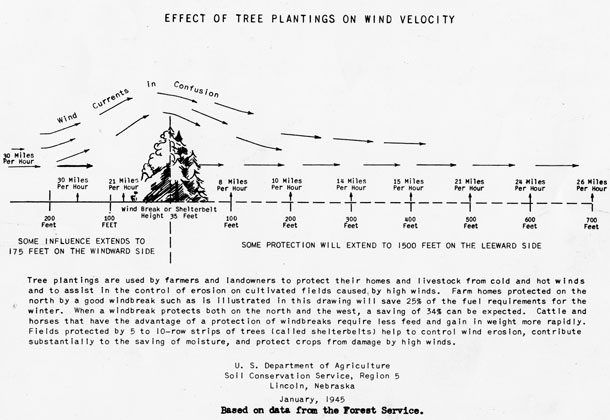
The shelterbelt design was simple: Lines of trees block the path of harsh winds, while also capturing water, providing a nutrient sink to crops, and habitat to native wildlife. (Photo: The Forest History Society, Durham, NC)
VAUGHAN: That's right. A lot farmers just don't see that payout from those cost sharing programs that they would like to, and even beyond that, you know, a lot of the agro foresters that I talked to said that you know we can show them the numbers all day long of increased yields from these shelterbelts being in place but at the end of the day, there's been so much investment in this new technology that we're using that they want to get the most out of the technology they've paid for, and so there is some sort of strange psychology going on where even when you see the numbers you're trying to justify other decisions you've already made on the farm, you've bought, you know, a giant combine that was very expensive, you've invested in center pivot irrigation and all those things you want to get your money's worth out of, and trees, unfortunately, they're just kind of forgotten about. They're left behind, they're not valued the way I think a lot of people understand they should be.
CURWOOD: So, what about irrigation? Of course, much of the plains area has the Ogallala aquifer under it. There's a lot of water but it's slowly disappearing. To what extent could irrigation be a possible solution for the region?
VAUGHAN: I would say that's where we're getting into trouble right now, Steve, and in fact, a big report came out I think the Denver Post kind of broke the story about this. They showed that the high plains aquifer was depleted twice as fast over the last six years as it was the previous 60 years. So, for people who are relying solely on using this ground water from the aquifer, I think we need to get away from that mode of thinking, and that's where all of these agroforestry officials are stepping in and saying, hey, these trees are still relevant and they're going to be more relevant the more water troubles we run into.
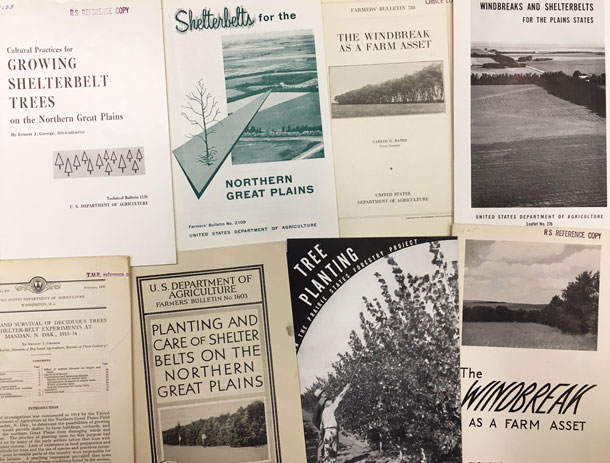
Pamphlets advertise the first plantings of shelterbelts in the Great Plains. Today, pressures to maximize profit have driven many farmers to cut down these once-heralded trees. (Photo: The Forest History Society, Durham, NC)
Right now, center pivot irrigation is reliant on very heavily in drought years, and it's great that we have that technology there and that we can use that when need be, but there's going to come a point when we can't always rely on that, and even if the water is still there it gets more expensive all the time. For a farmer to think that he can even afford to just irrigate his way out of a drought is really, I think, a damaging line of thought.
CURWOOD: I would imagine that the trees also affect the microclimate and add water and keep water in the soil locally. What evidence, if any, is there of that?
VAUGHAN: Yeah, I mean that's definitely true. Plenty of studies have shown that there is certainly is an effect on the microclimate, and that water retention is a big part of shelterbelts and a big part of why it helps retain the topsoil. They have their roots, they soak up the water, they provide sort of a nutrient sink for a lot of this farmland. They also provide shelter for wildlife, for birds, the birds help cut down on the insects. I mean there's all sorts of secondary benefits that these shelterbelts provide that you don't necessarily think about when you're a farmer just looking at the bottom dollar.
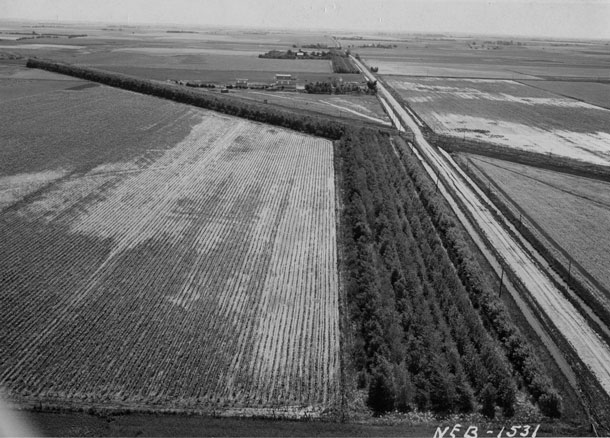
A 10-row shelterbelt planted in 1940 on the Dorothy A. Jones farm in Seward County, Nebraska. (Photo: The Forest History Society, Durham, NC)
CURWOOD: So how do locals feel about these shelterbelts, in particular, any sentimental attachments that would be appropriate to talk about?
VAUGHAN: There's a sentimental attachment by some farmers certainly, but there's also a sentimental attachment just by people who live out here in the plains who might not necessarily be running a farm or ranch. You know, I think of my own parents. I grew up in a small town in central Nebraska and the way I learned about shelterbelts, the way I even knew that term is because my parents would see another shelter belt coming down, and they would sort of bemoan, ‘Oh man I grew up with that shelterbelt,’ or ‘I've seen those trees all my life’ and they couldn't understand why farmers were ripping them out. And so, yes, certainly people have a sentimental attachment to it even when FDR was putting them in, the Forest Service director said don't underestimate the value of just the aesthetics of all these trees being out in what was once called The Great American Desert.

Carson Vaughan is a freelance journalist based in Lincoln, Nebraska. He partnered with the Weather Channel and the Food and Environment Reporting Network for his story. (Photo: Carson Vaughan)
CURWOOD: Carson, I got to say that the story feels ominously cyclical that things could be coming back to what happened on the scale of 80, 90, 100 years ago. How optimistic are you for the future of the Great Plains and the agriculture there?
VAUGHAN: Well, I certainly don't want to be alarmist in any way, and talking to a lot of these foresters, half would use the term "another dust bowl" and the other half would kind of shy away from that, but the half that shied away from it would still be saying, “We're going to see some pretty serious consequences”, and so I'm not optimistic that our farming practices are as progressive as they should be, and I don't think we're moving at a pace that we should be, but again that's not to say that there aren't plenty of farmers and ranchers out there who understand the benefits of this and are replanting their shelter belts. I am most concerned about the farmers that are tearing them out for a quick profit and forgetting to replant those trees.
CURWOOD: Carson Vaughan's a freelance journalist based in Lincoln, Nebraska, who partnered with The Weather Channel and the Food and Environment Reporting Network for the story. Carson, thank you so much for your time.
VAUGHAN: Thanks so much, Steve.
Links
The Weather Channel: “Uprooting FDR’s “Great Wall of Trees”
Shelterbelt Design blog: The Story of the Great Plains Shelterbelt Project
Living on Earth wants to hear from you!
Living on Earth
62 Calef Highway, Suite 212
Lee, NH 03861
Telephone: 617-287-4121
E-mail: comments@loe.org
Newsletter [Click here]
Donate to Living on Earth!
Living on Earth is an independent media program and relies entirely on contributions from listeners and institutions supporting public service. Please donate now to preserve an independent environmental voice.
NewsletterLiving on Earth offers a weekly delivery of the show's rundown to your mailbox. Sign up for our newsletter today!
 Sailors For The Sea: Be the change you want to sea.
Sailors For The Sea: Be the change you want to sea.
 The Grantham Foundation for the Protection of the Environment: Committed to protecting and improving the health of the global environment.
The Grantham Foundation for the Protection of the Environment: Committed to protecting and improving the health of the global environment.
 Contribute to Living on Earth and receive, as our gift to you, an archival print of one of Mark Seth Lender's extraordinary wildlife photographs. Follow the link to see Mark's current collection of photographs.
Contribute to Living on Earth and receive, as our gift to you, an archival print of one of Mark Seth Lender's extraordinary wildlife photographs. Follow the link to see Mark's current collection of photographs.
 Buy a signed copy of Mark Seth Lender's book Smeagull the Seagull & support Living on Earth
Buy a signed copy of Mark Seth Lender's book Smeagull the Seagull & support Living on Earth

